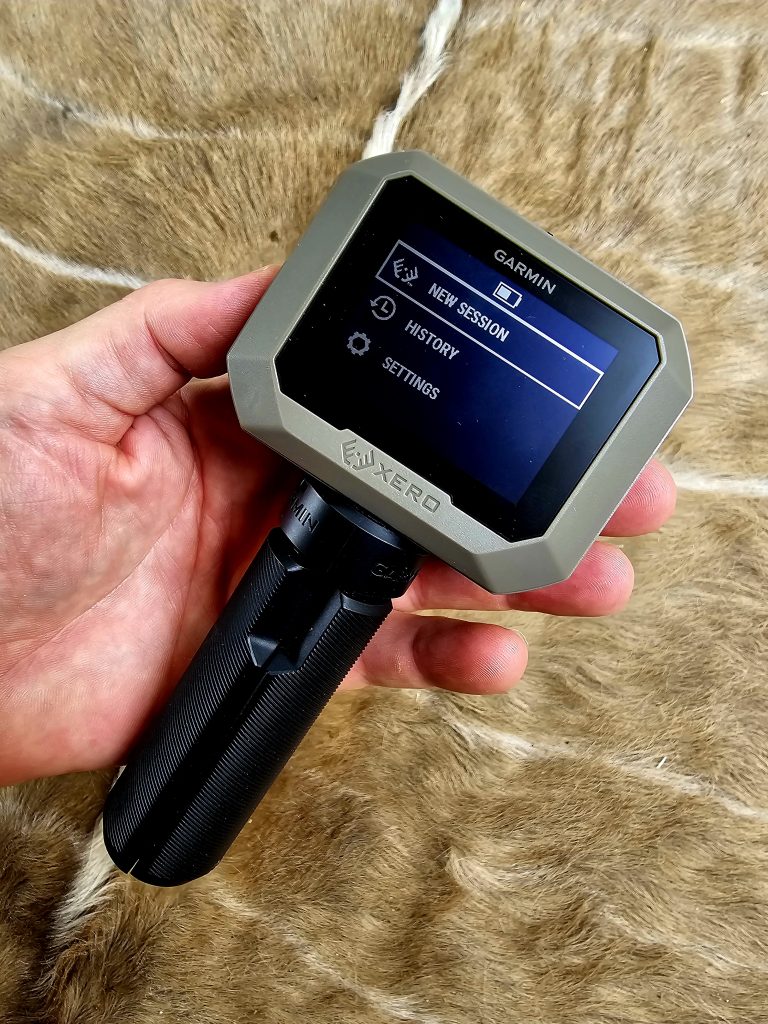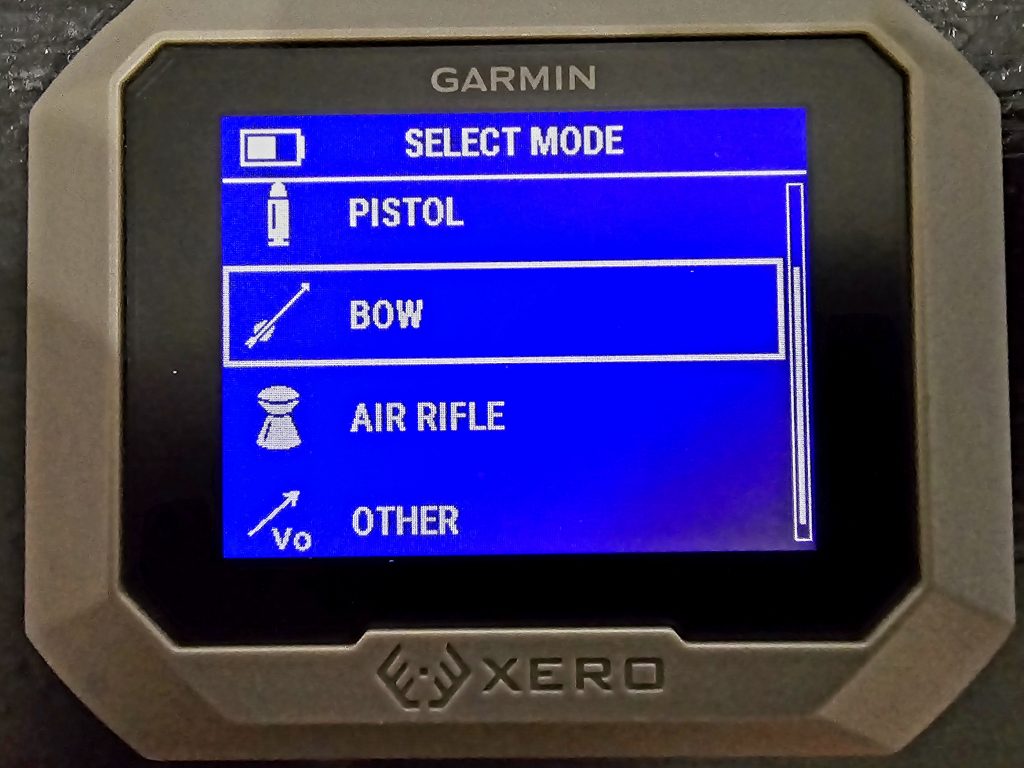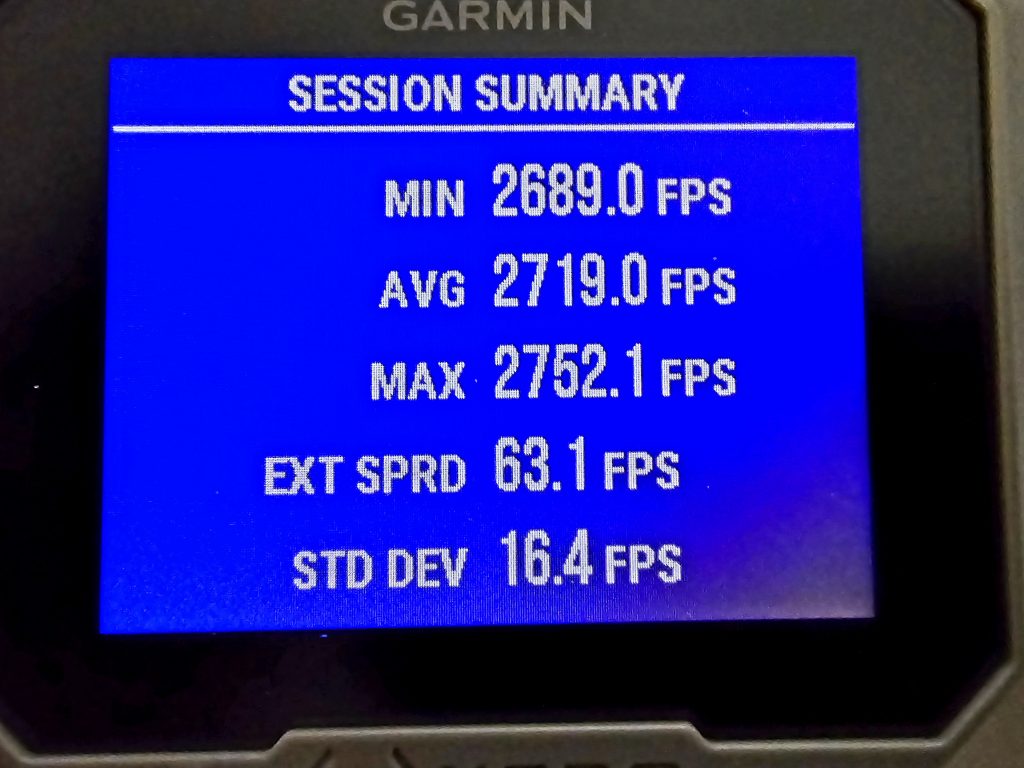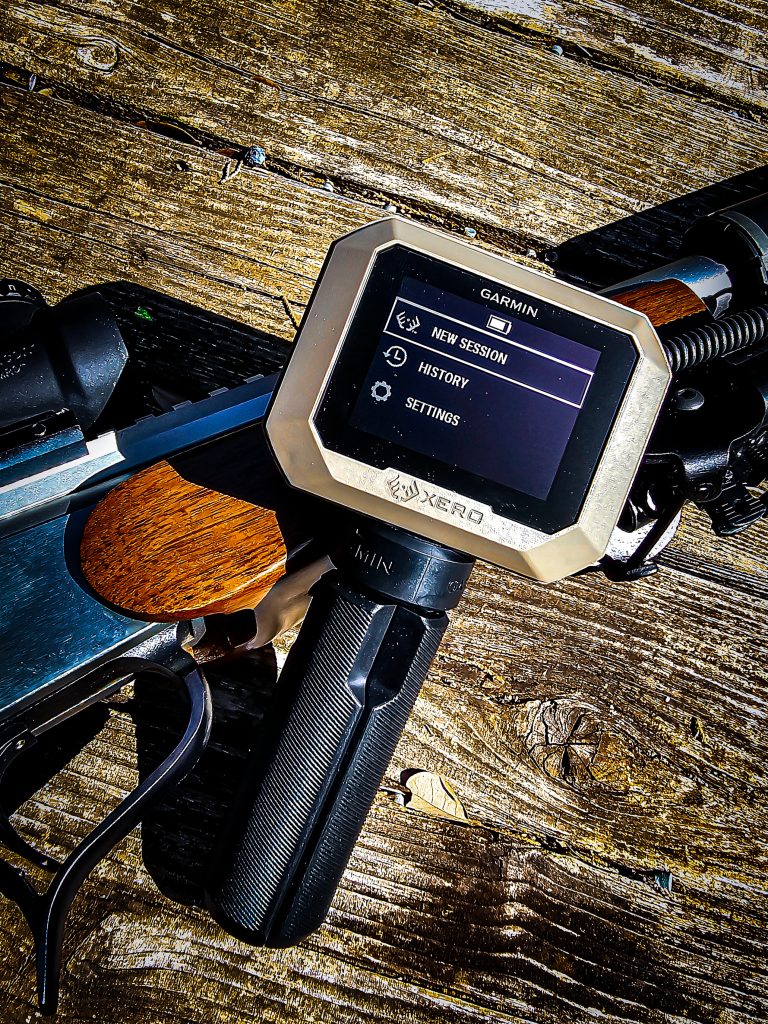
Everyone says the same thing about the Garmin Xero C1 Pro Chronograph — it’s a game changer. There’s a very good reason for that. It truly is a game changer. This is the best chronograph on the market and is so much better that it really does change how you’ll use a chronograph. There’s really no competition. It’s that much different and it’s that much better.
On a multi-nation hunt in Africa this last spring, I took the Garmin’s chronograph and put in in my pocket. Using the Xero C1 Pro, I shot at over 5,000 feet of elevation in 90+ degree heat in Namibia and got solid data that helped me make 500+ yard shots on game using a rifle with a fairly slow-moving bullet where accurate velocity readings are very important. Five days later I was on South Africa’s eastern coast at near sea level where it was 25 degrees cooler going after pygmy antelope where the margin for error is quite small. I got my data for that locale from the same chronograph I pulled from my pocket.
Back at home I was teaching youth marksmanship. Using the same Garmin chronograph, I did nothing more than set it down on its little tripod next to each of the 10 students while they zeroed to give each shooter an accurate muzzle velocity. I kept doing that throughout the day, showing the difference that ambient temperature makes in velocity. I recharged the batteries in my truck on the way home from the range.

There’s nothing on the market remotely close to that level of convenience, functionality, versatility, and portability.
One of the biggest advantages of the Xero C1 Pro is the incredible ease of set-up. Including turning it on, you have six pushes of a button to toggle through the set-up menu. Then just set it down on the supplied mini tripod 5 to 15 inches from the muzzle in the direction of fire, and you’re done. I timed it with my stopwatch. It takes a total of eight seconds from off to recording shots.
But maybe using the little supplied tripod doesn’t work for you. Maybe you need to get up higher. Cool. Just screw the chronograph onto any ¼-20 thread tripod. Or just attach it to your rifle’s Picatinny or ARCA Swiss rail using an adapter like the one from the always excellent folks at Area 419.

The Garmin chronograph is fully stand-alone. It doesn’t have to attach to anything. That means you get an accurate muzzle velocity reading without having to hang anything from your gun. It’s archery friendly, rifle friendly, pistol friendly, it loves suppressors and it reads just fine in the shade or indoors.
It also doesn’t need to be in perfect alignment with the shot path. Really, it just needs to be in the same general direction(ish) as the unobstructed bullet path. There’s no precise aiming needed. You don’t havve to so much as look over the device to see where it’s pointed. If it’s in general alignment with your barrel, you’re good to go.
You might think this would interfere with other shooters on the range. It does…but barely. If two shooters are within arm’s reach of each other, you can place the chronograph between them and get accurate readings for both. If you have a shooter within about 10 feet of you and don’t want to pick up their shots, just place the Garmin on the opposite side of your gun from them and it works just fine.
The Garmin provides accurate readings anywhere from 100 fps all the way up to 5,000 fps. That about covers it. The nice thing there is, because of the wide range of velocities and the ease of set-up, you can measure everything from the speed of a wooden arrow from a longbow all the way out to the fastest of the 22-250 Remington varmint rounds.

Garmin claims a 0.1% precision velocity measurement deviation. If that’s true, it’s as good or better than anything even remotely comparable on the market. In testing the Xero C1 Pro next to a Caldwell screen type chronograph, a new Magnetospeed chronograph, and a Labradar LX chronograph, the Xero C1 Pro seemed to provide more accurate results than any of the others, at least when measured against predicted bullet impact at transonic ranges.
In other words, the rounds were more likely to land where the math said they would if I used the Xero C1 Pro than any of the other chronographs I had access to, and that’s pretty much all the other major brands on the market.
The Xero C1 Pro really shouldn’t be any more accurate than the Labradar LX, at least on paper, but I owe the improved accuracy in reading to a simpler set-up and easy aiming of the device. The Garmin just seems to be less picky. All it needs is 20 yards for the projectile to travel and an unobstructed line of sight.
Garmin advertises a battery life of up to six hours or 2,000 shots on a charge. That seems about right from my experience. I’ve taught some long-range classes where we used the Garmin all day and by the end of the day it was dead. Those were long days of use where multiple shooters were getting readings throughout the day.

Since the Xero C1 Pro has a rechargeable battery with a simple USB Type C port, you can recharge it anywhere. The Garmin manual says that it takes “up to four hours” to fully recharge, but mine charged from dead to 100% using my truck’s USB port and a Type A to C cable in about two hours. It took about the same time using a portable battery pack. I’ve never actually had to recharge it on a hunt, even ones that lasted weeks, which makes sense as I only used it for maybe 10 shots over that time period.
The user interface is extremely simple. There are four buttons total. There are no deep hidden menus and all of the controls are well laid out. I don’t know how you could screw it up, but if somehow you did, resetting to factory settings is done in all of about four clicks.
The Pro version allows you to input your projectile weight so that the device accurately computes muzzle energy with every shot. That’s particularly valuable for folks in competitions worrying about power factor.

The menus provide all of the data for muzzle velocity and muzzle energy you would likely need. It automatically keeps a log of your shot strings and you can revisit each shot individually right there on the device.
That said, you can also pair it with Garmin’s Shot View application via Bluetooth and you can even connect that data to the cloud to keep a record of it or transfer the data between devices. If that’s not enough for you, you can export the data as a .csv file and manipulate it or transfer it at your leisure.
Finally, the Xero C1 Pro is tiny. At about 3x2x1 inches and weighing in at less than 6 oz, you really can just put this thing in a pocket and go. There’s always room for it in a range bag, rifle bag, luggage, or with your hunting gear. I’ve gotten in the habit of not shooting anywhere without it.
It’s so small and easy to use there’s simply no reason not to take it with me to the range or on hunting trips where I need to travel. Head to any larger long-range match and you’re likely to see several people with the Xero C1 chronograph attached to their rifle for the entirety of the competition. It’s that small and out of the way.

At about $600 MSRP, the Garmin Xero C1 Pro Chronograph isn’t inexpensive. It is, however, worth every penny. Seriously, I hated spending that kind of money when I already had several chronographs, but after using it this past year I would have paid double that if I had known what I know now. Since my first range session with the Garmin I haven’t so much as turned on any of my other chronographs, other than for comparisons in this review.
Not too many folks would have guessed that Garmin would come out as a leader in shooting sports technology, but between the Xero C1 Pro Chronograph and their tactix 7 Applied Ballistics watch, they certainly have made their mark on the industry. As demonstrated by the demand, Garmin has created a chronograph that’s leaps and bounds ahead of their competition to the extent that it’s changed how people use chronographs entirely. “Game changer” is absolutely right.
Specifications
DIMENSIONS: 3.03″X2.38″X1.36″ without tripod
WEIGHT: 105.6 g without tripod, 161 g with tripod
WATER RATING: IPX7
DISPLAY TYPE: sunlight-visible, transflective, monochrome
DISPLAY SIZE: 1.3″ x 1.7″ (33 mm x 44 mm), 2.2″ diagonal (55 mm)
DISPLAY RESOLUTION: 240 x 320 pixels
BATTERY TYPE: internal rechargeable lithium-ion battery; nonreplaceable
OPERATING RANGE: -10° C to 55° C (14° F to 131° F)
MEMORY/HISTORY: 50 sessions at max 100 shots per round before a ShotView™ app sync is required to save data to phone
INTERFACE: USB-C
MSRP: $599.99 (found online for $599.99)

Features aside is this as dummy proof/easy as it looks and sounds?
Yes. It truly is a game-changer, as JWT says. Not inexpensive, but easily better than everything else out there.
The ease of setup alone is what caught my attention the rest well not inexpensive may still be well priced
When I was a boy I was in a series of classes for what was then called “functionally mentally retarded children”, and this Garmin chrono was easy for me. So there’s that.
Vet friendly got it 🙂
Hello – off-topic question for JWT: I’m looking at buying my first bolt-action rifle and would like to select a caliber that is capable for game throughout the lower 48, especially for longer-range hunting in the western US. I’m considering a newer, more efficient cartridge such as 7mm PRC, but wondering if you recommend other options for the use case? Thanks!
The 7PRC is a fine caliber. But if you wanted a “do it all” caliber the .30-06 is still the king.
https://fieldethos.com/the-venerable-aught-six/
Much appreciated!
As neat as so many of the newer calibers are the combination of ubiquity, versatility, and high end of adequate power for most demands are damn near unbeatable with the only realistic area for improvement to be a more compact package (308 but lose the heavy loadings) with the same capabilities (maybe something based of the new 6.8 case construction for silly levels of pressure).
Thanks SAFE! -06 has remained popular this long for a reason 🙂
270 as well covered very thoroughly by uncommon sense below. I typically do not find as many reloading components for that in any vaguely similar variety as for the 06 but it is a great everything but larger critter round….. including for dealing with steel plates at 100 or so yards
JustMe,
I had the same question several years ago and a knowledgeable friend recommended either .30-06 Springfield or .270 Winchester.
My friend (and subsequent research) did say that .270 Winchester is too light for ethical moose and grizzly bear hunting. So, if you believe that you will never hunt moose and grizzly, then .270 Winchester could be a good choice with a bit less recoil than .30-06 Springfield. Note that .270 Winchester shoots flatter than .30-06 Springfield at very long ranges (if I remember correctly) such as you may encounter hunting in the wide-open spaces of the Western United States.
For reference the .270 Winchester cartridge is essentially a .30-06 Springfield cartridge necked down to .27 caliber. So you are getting almost the same case volume of propellant pushing a bullet with a smaller frontal surface area. That typically results in markedly higher bullet velocities both at the muzzle as well as far down range.
Awesome, thanks Uncommon! Initially I was thinking a “quiver of one” caliber but I could see a strong case for ending up with a rifle in each of -06 and .270 — fortunately we seem to have plenty of great rifles on the market to choose from these days.
I would love to buy one of these: alas I just took the deep dive and started the process to purchase my first two suppressors. That expenditure has tapped me out for this year. Until then, I will have to rely on my Caldwell chronograph which I purchased several years ago for about $70 on sale. So far, it has seemed to work pretty well, although it was unable to give me velocity readings from my muzzleloader which generated far too much smoke (and way far beyond the barrel) to read the velocity.
As long as you are relying on the Caldwell as a starting point only, it works fine. Under the best-case scenario, they are 50fps off one way or another and often a lot more, from my experience with them. They give a fine starting point but you’re going to definitely require a good bit of truing. (assuming you are shooting on a bright day)
Good to know. Thank you for the feedback Mr. Taylor.